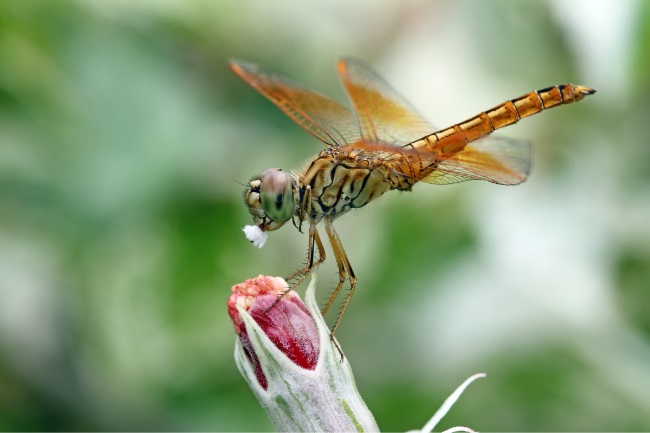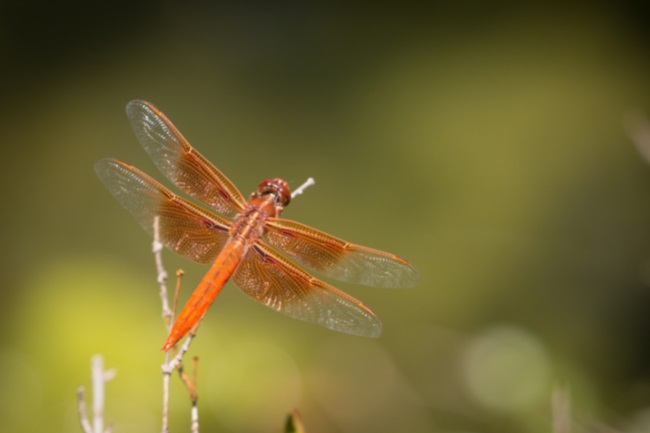Most species of dragonfly spend the winter in their larval form, or as an egg. Generally, the adults will die off, and the young with either continue feeding below the surface of the water or enter diapause, a type of hibernation. Some dragonflies also migrate.
Contents
How do dragonflies survive the winter?

Dragonflies are a type of insect, which means they are cold-blooded. Unlike mammals, which are warm-blooded, insects don’t create their own heat (aside from a small amount generated by movement). This means they need to make use of the warmth of the sun. At night and in winter, the lack of external heat means they have to develop clever strategies to survive.
Given this particular set of constraints, how do dragonflies get through the winter? They can use a number of different techniques, which range between species, and even sometimes within them.
| Dragonfly Species | Hibernation Behavior |
|---|---|
| Autumn Meadowhawk | Hibernates as adults in sheltered areas such as leaf litter or tree bark |
| Twelve-spotted Skimmer | Hibernates as adults in protected areas such as burrows or crevices |
| Chalk-fronted Corporal | Hibernates as nymphs in underwater burrows or in muddy substrate |
| Common Hawker | Hibernates as nymphs in mud or submerged vegetation |
Dragonflies that overwinter as eggs
Many dragonflies overwinter as eggs. These eggs are laid usually at the end of summer after the adults have mated. Some dragonfly species can lay their eggs directly in the water, where they may sink to the bottom or become attached to aquatic plants. Other species may lay their eggs outside the water, such as in slits the female dragonflies make in vegetation.
These eggs either enter diapause, which is a type of hibernation, or hatch out into larvae. Entering diapause means they will stop developing until the weather warms, meaning they will spend the winter in an egg form, not developing any further.
There are benefits of remaining as an egg throughout winter. This is a hard time when food is scarce. The small eggs are easily hidden from hungry scavengers and require little energy use throughout this time. The downside is that the egg is not able to move, meaning that if conditions change, and become unsuitable for the egg, it may die.
Also read: How Long Does a Dragonfly Live for? (Lifecycle Explained)
Dragonflies that overwinter as larvae

Larvae are juvenile dragonflies, and can also be called nymphs. They live within the water and spend their time hunting smaller invertebrates. Many dragonflies species overwinter in the water as larvae. This is in part because water temperatures take longer to lose the warmth of the summer sun, keeping warmer for longer. Additionally, as long as the water is deep enough, ice may form on the top, insulating the water beneath.
Overwintering as a larva has the added advantage that the dragonfly can move around and feed. This means it can continue to grow throughout the winter, and also change locations if conditions worsen. The downside is that larva also makes a tasty snack for other species, and are harder to hide than a tiny egg.
Not all larvae remain active over winter. Some larvae may enter diapause. This means they can cope with the cooler condition and are not growing, so do not need to hunt for food. Many dragonfly species can spend several years as larva, and therefore spend many winters living as juveniles within pools or watercourses.
Also read: What Does a Dragonfly Eat and Drink? (Habits Explained)
Do dragonflies hibernate as adults?
In many insects, the main aim of their adult form is to produce offspring. Most dragonflies will spend the largest proportion of their lives as larvae, only becoming an adult for a few weeks or months. Within this time they will feed and hunt but their main aim is usually to defend a territory and bag a suitable mate.
Once mating is complete, and the eggs are safely laid, their life’s work is completed. They aren’t designed to have a second go the following year, meaning that the adults tend to die by the end of the summer, not needing to enter hibernation.
Dragonfly migration

Although we have been aware that many species of dragonflies migrate for over a century, the migration of dragonflies is still little understood. This is in part because the migration of small insects is more difficult to observe and track than that of larger animals like birds and mammals.
Only a small proportion of species migrate, with most only moving a small way from where they emerge from their larval form into the adults. More confusingly, within some species, there are populations that migrate and others that don’t.
These two populations may even use the same areas, simply employing different strategies for coping with the approach of winter.
Dragonfly migration takes place on every continent aside from Antarctica. Within the UK the majority of the migrants come in from mainland Europe. These migrants tend to arrive for the summer, and breed in the UK. Species include those which are already resident in the UK, such as the migrant hawker, or others that are not usually found here, such as the lesser emperor.
| Dragonfly Species | Migration Behavior |
|---|---|
| Green Darner | Migratory; travels long distances |
| Wandering Glider | Migratory; travels long distances |
| Common Whitetail | Partial migration; some individuals migrate, while others hibernate |
| Variegated Meadowhawk | Non-migratory; remains in its habitat throughout the year |
In the US the migration tends to be during the Autumn with dragonflies heading from the North down to the South, usually in pursuit of warmer weather. Migration also occurs north, though larger groups of migrating dragonflies seem to be observed in the Autumn wave. The insects can sometimes gather in great clouds or ribbons, particularly before crossing large bodies of water.
The green darner
The green darner dragonfly has one of the most studied migrations of any species of dragonfly. This dragonfly completes its journey in three stages. The first generation emerges in the spring in the southern states, Mexico, and the Caribbean. The adults then fly north in February, where they lay their eggs. These eggs either emerge in the summer and head back down the continent in the Autumn, or they may overwinter where they are as juveniles. Finally, the third generation is laid in the south, where it spends the winter before laying the generation that returns up north.
Such a complex migration is reminiscent of the monarch butterfly, yet much less studied and celebrated.
Survival of the fittest
We have a tendency to think that animals find one strategy for survival and stick to it, but in reality, within populations, there may be many different strategies at play. Indeed, a species is most robust if there are a few different options being explored at any one time. Of course, this means that there will be winners and losers, but it also means that there will never be only losers.

